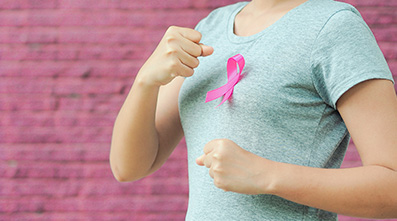What is breast cancer?
Breast cancer is a disease in which abnormal cells grow uncontrollably in the breast tissue, forming a lump or tumour. It can develop in different parts of the breast, such as the lobules or ducts, and in some cases, spread to nearby lymph nodes or other organs. While it affects women most often, men can also be diagnosed with breast cancer. Early detection through regular self-examinations and medical screenings plays a crucial role in improving treatment outcomes.
Breast Cancer is the most common type of Cancer that women across all ages suffer from. Studies show that 1 out of every 38 women dies due to breast cancer. Over the years, breast cancer awareness has grown significantly, helping more people understand the importance of early detection, screening, and timely treatment. This increased awareness in the general population has contributed to better survival rates and more informed healthcare decisions.
Causes
Many people often wonder what causes breast cancer. A woman’s breast consists of lobules, connective tissue and fats. The lobules are milk-producing tiny glands connected to tiny ducts which carry milk to the nipples.
In cancer, the cells grow and divide uncontrollably. This excessive cell growth, causes the nearby tissue to die as the cancerous tumour uses up all the nutrients and energy meant for the tissue around it.
Starting from the inner lining of milk ducts or the lobules, it can spread to other lymph nodes and other parts of the body.
Types
Breast cancer can be classified according to the place of origin as-
Symptoms
- Pain in the breast or the armpits.
- Pitting or reddening of the skin on the breast
- Peeling, flaking or scaling of the breast skin
- Rash on or around either or both of the nipples
- Discharge (possibly containing blood) from the nipples
- Sunken or an inverted nipple
- A change in the shape, size or feel of the breast

Stages of breast cancer
Stage 0- Carcinoma in situ or ductal carcinoma in situ, in this the cancer cells are limited to the ducts and have not yet invaded the surrounding tissue.
Stage 1- Typically characterized by tumour up to the size 2 cm across, the cancer cells have not yet or minimally entered the lymph nodes.
What is the cure for breast cancer?
While there is no single guaranteed cure, early detection combined with timely treatment—such as surgery, radiation therapy, chemotherapy, hormone therapy, or targeted therapy—can significantly improve recovery chances. The choice of treatment depends on the stage, type, and spread of the cancer. Additionally, having adequate insurance coverage, such as a stand-alone cancer policy, can help manage the high costs of treatment and hospitalization.
FAQs:
Q: What are the different types of breast cancer?
A: The main types of breast cancer are classified based on where the cancer begins. The two most common are ductal carcinoma, which starts in the ducts that carry milk to the nipple, and lobular carcinoma, which begins in the lobules that produce milk. Breast cancer can also be categorized as invasive, where cancer cells spread to nearby tissues, and non-invasive, where cancer remains in its place of origin.
Q: How is breast cancer staged?
A: Breast cancer stages range from Stage 0 (cancer limited to ducts) to Stage 4 (cancer spread to other organs). The stage depends on tumour size, spread to lymph nodes, and metastasis.
Q: Why is breast cancer awareness important?
A: Breast cancer awareness encourages early detection, regular checkups, and informed decisions about prevention and treatment, which can save lives.
Q: What causes breast cancer?
A: Breast cancer occurs when abnormal cells in the breast grow uncontrollably, using up nutrients and damaging surrounding healthy tissue. It can start in the ducts or lobules and may spread beyond the breast.


 5 Minute
|
5 Minute
|

 5 Minute |
5 Minute |